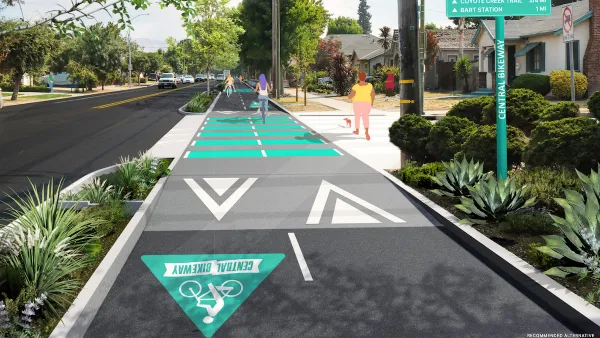Single-stair building construction is having a resurgence in the United States, where, for the last several decades, zoning codes have required more than one staircase in multi-story housing developments.

A design competition hosted by the American Institute of Architects’ Baltimore chapter challenged architects and design enthusiasts to create visions for single-stair residential buildings, a typology that is making a comeback in some U.S. cities as local governments move to re-legalize it. Robert Steuteville outlines the contest’s results in the Congress for New Urbanism journal Public Square.
For decades, building codes required more than one staircase in residential buildings with multiple stories, citing safety and evacuation concerns. However, advocates for single-stair buildings argue that modern building materials and techniques, along with new knowledge about fire prevention and technology, make single-stair buildings just as safe as others.
The design competition followed on the heels of a proposed Baltimore bill that would modify the city code to allow single-stair buildings up to six stories, “provided they incorporate enhanced fire safety measures.”
“During the panel, the jury members repeatedly emphasized the practical value of the contestants' efforts, specifically providing compelling visualizations of the single-stair building typology within the context of Baltimore's urban fabric. As juror Marques King noted, single-stair can serve as a community engagement tool by offering a new urban form that is more visually appealing, humane, and incremental than the over-scaled monolithic structures and double-loaded corridor buildings that are an unfortunate outcome of current zoning codes.”
FULL STORY: Competition reveals practical single-stair designs

Planetizen Federal Action Tracker
A weekly monitor of how Trump’s orders and actions are impacting planners and planning in America.

Silicon Valley ‘Bike Superhighway’ Awarded $14M State Grant
A Caltrans grant brings the 10-mile Central Bikeway project connecting Santa Clara and East San Jose closer to fruition.

Amtrak Cutting Jobs, Funding to High-Speed Rail
The agency plans to cut 10 percent of its workforce and has confirmed it will not fund new high-speed rail projects.

California Set to Increase Electric Truck Chargers by 25%
The California Transportation Commission approved funding for an additional 500 charging ports for electric trucks along some of the state’s busiest freight corridors.

21 Climate Resilience Projects Cancelled by the EPA
The federal government has pulled funding for at least 21 projects related to farming, food systems, and environmental justice to comply with one of Trump’s early executive orders.

Trump Executive Order on Homelessness Calls for Forced Institutionalization
The order seeks to remove legal precedents and consent decrees that prevent cities from moving unhoused people from the street to treatment centers.
Urban Design for Planners 1: Software Tools
This six-course series explores essential urban design concepts using open source software and equips planners with the tools they need to participate fully in the urban design process.
Planning for Universal Design
Learn the tools for implementing Universal Design in planning regulations.
Yukon Government
Caltrans
New Jersey Institute of Technology
Mpact (founded as Rail~Volution)
City of Camden Redevelopment Agency
City of Norman, Oklahoma
City of Portland
City of Laramie





























